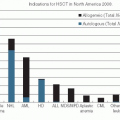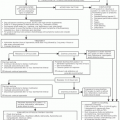Problem |
Time
Seen after
Chemotherapy |
Clinical Signs and
Symptoms |
Laboratory
Findings |
Treatment Options |
Course |
Mucositis and ulceration |
5-16 d after initiation of chemotherapy |
Mucosal erythema Shallow or deep ulcerations on mucosa Poorly defined borders Usually on nonkeratinized tissue Very painful |
Secondary infection may be present |
Palliation: Topical and systemic analgesics Please see Table 12.7 for detailed management guidelines If secondary infection, systemic antibiotics to cover gram-negative organisms in addition to conventional gram-positive flora If hemorrhage, topical thrombin Soft bland diet as tolerated |
Resolves after cessation of chemotherapy |
Xerostomia |
Variable |
Dry mouth Thick ropy saliva Dysgeusia difficulty with speech and nutrition |
Noncontributory |
Sodium bicarbonate mouth rinse to decrease viscosity of oral environment Lemon drops (with artificial sweeteners; used only for acute management) Sugarless gum Saliva substitutes Sialogogues: Pilocarpine, cevimeline
High-strength fluoride toothpaste prescription to prevent dental caries |
Usually resolves after cessation of chemotherapy |
Dysgeusia |
Variable |
Decreased taste or abnormal taste |
Noncontributory |
Maintain adequate nutritional intake while the condition is present
Counseling for prevention of dysgeusia |
Usually resolves after cessation of chemotherapy |
“Odontogenic” pain of neurotoxic origin |
During course of neurotoxic agent (e.g., vincristine and vinblastine) |
Spontaneous, constant, dental pain often mimicking pulpitis Difficult to localize May be bilateral Afebrile No swelling, lymphadenopathy, significant caries, or periodontitis |
Noncontributory |
Gabapentin, carbamazepine Systemic analgesics |
Resolves after discontinuation of neurotoxic agent |
Acute necrotizing ulcerative gingivitis |
Variable. May be unrelated to chemotherapy, but incidence increases with neutropenia |
Gingival pain and bleeding Fever Lymphadenopathy Gingival necrosis with punched-out papillae Oral malodor |
May see leukocytosis if no myelosuppression Fusospirochetal smear (positive) |
Systemic antibiotics, penicillin drug of choice; oral debridement |
Resolves after appropriate therapy in 10 d |
Candidiasis |
Variable, more likely with prolonged neutropenia, antibiotics, or steroid use |
White curd-like lesions or erythematous atrophic areas Mild pain or burning, often asymptomatic Affects dorsal tongue and buccal and palatal mucosa Corners of mouth may be affected, especially in edentulous patients (see angular cheilitis) |
Neutropenia, (positive) smear for Candida spp. |
Clotrimazole troches Systemic antifungals, for example, fluconazole |
Resolves with antifungal therapy or with marrow recovery |
Angular cheilitis |
Variable, incidence increases with xerostomia |
Cracking, bleeding, possible exudate and pain in corner of mouth |
Smear will likely demonstrate fungi |
Nystatin ointment Nystatin/triamcinolone combination ointment Check occlusal vertical dimension |
Usually resolves with antifungal therapy |
Herpes simplex infection |
Variable |
Commonly on lip near the mucocutaneous junction (herpes labialis); in immunocompromised patients intraoral ulcerative lesions can occur |
Seropositive Increased nuclearcytoplasmic ratio Viral inclusion bodies |
Prevention: Keep lips lubricated; this is often a secondary infection in a neutropenic host Treatment: Topical or systemic antivirals, for example, acyclovir |
10-14 d, depending on immune status |
Salivary gland infection |
Variable, most common in debilitated patients with diminished oral intake and dehydration |
Swelling (may be unilateral or bilateral) Pain Suppuration from salivary duct Xerostomia Fever |
Variable, (positive) bacterial or viral cultures, CMV common |
Antibiotics (systemic) to cover Staphylococcus spp. if bacterial Rehydrate Watch for possible airway obstruction |
Resolution depends on host status and treatment |
Odontogenic infection |
Variable |
May present with fever of unknown origin, pain, lymphadenopathy Swelling not a consistent finding with neutropenia May be subclinical until neutropenia develops |
Neutropenia Blood culture may be positive |
Pulpal therapy or extraction in presence of adequate cell counts (e.g., platelets >40,000/mm3) In immunosuppressed patients, consider systemic broad-spectrum antibiotics to cover for opportunistic organisms and normal flora |
Variable; depends on organism, hematologic status, extent of infection |
Mucosal bleeding |
10-14 d after initiation of chemotherapy |
Hematoma or bleeding, especially from mucosal sites commonly traumatized In case of neutropenic patient, likely chance of secondary infection Possible airway obstruction due to sublingual or pharyngeal extension |
Thrombo cytopenia Blast crisis with functional decrease in platelets |
Remove partial and full dentures Remove orthodontic bands or retainers Cover for secondary infection Topical/systemic aminocaproic acid Topically applied: Thrombin, microfibrillar collagen, epinephrine |
Resolves with increased platelets Resolving hematoma may extrude a granulation plug from the healing base; this should not be disturbed |
Gingival bleeding |
Variable, typically 10-14 d after initiation of chemotherapy |
Marginal hemorrhage from gingiva May be spontaneous if platelets <40,000/mm3 |
Thrombo cytopenia |
Platelet transfusion Topical thrombin, microfibrillar collagen, epinephrine Topical thrombin, microfibrillar collagen, epinephrine
Aminocaproic acid Pressure therapy Undisturbed clot Avoid trauma to site |
Resolves as platelet count increases |
Modified from Natl Cancer Inst 2010 PDQ website: Oral complications of chemotherapy and head/neck radiation. |
http://www.cancer.gov/cancertopics/pdq/supportivecare/oralcomplications/healthprofessional. |








